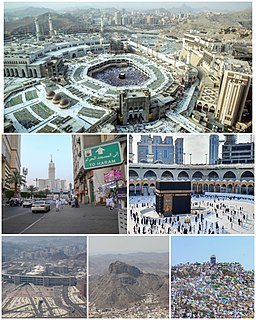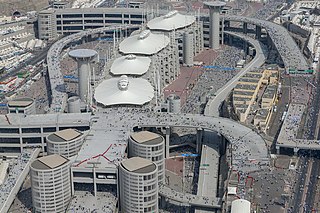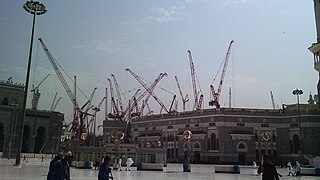Related Research Articles

Mecca, officially Makkah al-Mukarramah and commonly shortened to Makkah, is a city and administrative center of the Mecca Province of Saudi Arabia, and the holiest city in Islam. It is 70 km (43 mi) inland from Jeddah on the Red Sea, in a narrow valley 277 m (909 ft) above sea level. Its last recorded population was 1,578,722 in 2015. Its estimated metro population in 2020 is 2.042 million, making it the third-most populated city in Saudi Arabia after Riyadh and Jeddah. Pilgrims more than triple this number every year during the Ḥajj pilgrimage, observed in the twelfth Hijri month of Dhūl-Ḥijjah.

The Stoning of the Devil is part of the annual Islamic Hajj pilgrimage to the holy city of Mecca in Saudi Arabia. During the ritual, Muslim pilgrims throw pebbles at three walls, called jamarāt, in the city of Mina just east of Mecca. It is one of a series of ritual acts that must be performed in the Hajj. It is a symbolic reenactment of Ibrahim's hajj, where he stoned three pillars representing the temptation to disobey God.
The 1987 Mecca incident was a clash between Shia pilgrim demonstrators and the Saudi Arabian security forces, during the Hajj pilgrimage; it occurred in Mecca on 31 July 1987 and led to the deaths of over 400 people. The event has been variously described as a "riot" or a "massacre". It arose from escalating tensions between Shia Iran and Sunni Saudi Arabia. Since 1981, Iranian pilgrims had held an annual political demonstration against Israel and the United States, but in 1987, a cordon of Saudi police and the Saudi Arabian National Guard had sealed part of the planned anti-Western demonstration route, leading to a confrontation between them and the pilgrims. This escalated into a violent clash, followed by a deadly stampede. According to some beliefs, the conflict depended less on the religious centrality of the site and more on political choreography.

Mount Arafat, and by its other Arabic name, Jabal ar-Raḥmah, is a granodiorite hill about 20 km (12 mi) southeast of Mecca, in the province of the same name in Saudi Arabia. The mountain is approximately 70 m (230 ft) in height, with its highest point sitting at an elevation of 454 metres.

There have been numerous incidents during the Hajj, the Muslim pilgrimage to the city of Mecca, that have caused loss of life. Every follower of Islam is required to visit Mecca during the Hajj at least once in his or her lifetime, if able to do so; according to Islam, the pilgrimage is one of the Five Pillars of Islam. During the month of the Hajj, Mecca must cope with as many as three million pilgrims.
The 2006 Hajj stampedeor crush resulted in the deaths of 363 pilgrims on 12 January 2006 during the Hajj in Mecca. It took place on Jamaraat Bridge around 1pm on 12 January 2006, the fifth and final day of the Hajj. Between two and three million pilgrims attended the Hajj in 2006. Earlier, on 5 January at least 76 pilgrims died when a hostel collapsed in Mecca.

Mina, also transliterated as Muna, and commonly known as the "City of Tents" is a valley and neighborhood located in the Masha'er district in the Makkah Province of Saudi Arabia, 8 kilometres southeast of the city of Mecca, covering an area of approximately 20 km2 (7.7 sq mi). Mina incorporates the tents, the Jamarat area, and the slaughterhouses just outside the tent city.

The Jamaraat Bridge is a pedestrian bridge in Mina, Saudi Arabia, near Makkah used by Muslims during the Hajj ritual Stoning of the Devil. The purpose of the bridge is to enable pilgrims to throw stones at the three jamrah pillars either from the ground level or from the bridge. Jamaraat is the plural of jamraah, the Arabic term for each of the pillars involved in the stoning ritual. It literally means a small piece of stone or a pebble.

The Hajj is an annual Islamic pilgrimage to Mecca, Saudi Arabia, the holiest city for Muslims. Hajj is a mandatory religious duty for Muslims that must be carried out at least once in their lifetime by all adult Muslims who are physically and financially capable of undertaking the journey, and of supporting their family during their absence from home.
The Mecca fire of 1997 was a fire that occurred in the tent city near Mecca in Saudi Arabia 15 April 1997, killing between 217 and 300 people.

A crawler crane collapsed over the Masjid al-Haram in Mecca, Saudi Arabia, around 5:10 p.m. on 11 September 2015, killing 111 people and injuring 394 others. The city was preparing for the Hajj pilgrimage. The accident has been cited as the deadliest crane collapse in history, with the previous most deadly incident being the collapse of a construction crane in New York City in 2008, killing seven people.

On 24 September 2015, a "crush and stampede" led to the death of over 2,000 individuals, many of whom were suffocated or crushed during the annual Hajj pilgrimage in Mina, Mecca, Saudi Arabia, making it the deadliest Hajj disaster in history. Estimates of the number of dead vary: the Associated Press reported 2,411 dead, while Agence France-Presse reported 2,236 killed. Based on the total of the individual national reports cited in the table below, at least 2,431 people died. The government of Saudi Arabia officially reported two days after the event that there had been 769 deaths and 934 injured. These figures remained official at the time of the following year's Hajj and were never updated. The largest number of victims were from Iran, followed by Mali and Nigeria.
On 3 July 1990, an incident occurred during the Hajj in which 1,426 people were suffocated and trampled to death in a tunnel near Mecca.
The 1994 Hajj stampede resulted in the deaths of at least 270 pilgrims on 23 May 1994 during the Hajj in Mecca during the Stoning of the Devil ritual.
The 1998 Hajj stampede resulted in the deaths of at least 118 pilgrims on 9 April 1998 during the Hajj in Mecca during the Stoning of the Devil ritual on Jamaraat Bridge.
The 2001 Hajj stampede resulted in the deaths of at least 35 pilgrims on 5 March 2001 during the Hajj in Mecca. The incident took place during the Stoning of Satan ritual. The pilgrims were killed after a large crowd surged towards one of the three giant pillars representing the devil at which worshippers cast stones. A civil defense official later attributed the casualties to congestion and jostling among the pilgrims, resulting in some, particularly the elderly, tripping and falling.

Bilkisu Yusuf, also known as Hajiya Bilkisu Yusuf,, was a Nigerian journalist, columnist and editor for prominent newspapers in Abuja, Kano and Kaduna, Nigeria. She is known in Nigeria for being the first woman to direct a national newspaper operation and served as editor for two more. She was a Hausa, Muslim, feminist, of Yoruba descent and advocate for interfaith society, who was known for being an adviser to the Nigerian President on International Affairs and the founding of NGOs, such as Women In Nigeria (WIN) and the Federation of Muslim Women's Association (FOMWAN). Yusuf was killed in the 2015 Mina stampede while on Haj in Mecca, Saudi Arabia.

The COVID-19 pandemic affected the 2020 Hajj (pilgrimage), which is the fifth pillar of the Five Pillars of Islam, where millions of Muslims from around the world visit Mecca and Medina every year during Hajj season for a week. Over 2,400,000 pilgrims attended Hajj in 2019. Due to the highly contagious nature of COVID-19 in crowded places, various international travel restrictions, and social distancing recommendations, the Ministry of Hajj and Umrah advised Muslims to postpone their pilgrimage until the pandemic was mitigated. However, in June 2020, the Ministry opened up Hajj to people of all nationalities residing in Saudi Arabia, with foreigners still banned from attending to ensure pilgrims' safety and prevent the transmission of COVID-19.

Crowd collapses and crushes are catastrophic incidents that can occur when a body of people becomes dangerously overcrowded. When a body of people reaches or exceeds the density of four to five people per square metre, the pressure on each individual can cause the crowd to collapse in on itself, or become so densely packed that individuals are crushed and asphyxiated. At this density, too, a crowd can start to act like a fluid, sweeping individuals around without their volition. Such incidents are invariably the product of failures of organization, and most major crowd disasters can be prevented by simple crowd management strategies. Such incidents can occur at large gatherings such as sporting, commercial, social, or religious events, though the critical factor is crowd density rather than crowd size. It is estimated that some 66,000 people were injured in crowd collapse and crush incidents between 1992 and 2002, though crowd scientists believe this to be a gross underestimate.
References
- ↑ "A Stampede Near Mecca Killed More Than 700 People Taking Part In the Hajj Pilgrimage". Mother Jones . Retrieved 30 September 2015.
- ↑ "BBC NEWS – Hundreds killed in Hajj stampede". News.bbc.co.uk. Retrieved 11 October 2014.
- ↑ "History of disasters during Hajj celebration in last 25 years" . The Independent. 2015-09-24. Archived from the original on 2022-05-01. Retrieved 2019-05-03.
- ↑ "CNN.com - Hajj stampede: 244 pilgrims dead - Feb. 1, 2004". edition.cnn.com. Retrieved 2019-05-03.